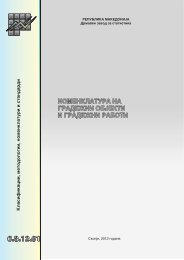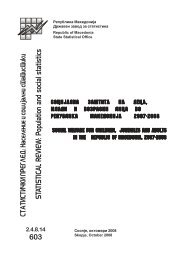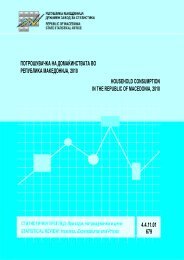586 potro[uva^ka na doma]instvata vo republika makedonija, 2007 ...
586 potro[uva^ka na doma]instvata vo republika makedonija, 2007 ...
586 potro[uva^ka na doma]instvata vo republika makedonija, 2007 ...
You also want an ePaper? Increase the reach of your titles
YUMPU automatically turns print PDFs into web optimized ePapers that Google loves.
Moreover, the agricultural households refer to the:<br />
- households of agricultural workers with no land who work regularly on the holdings of other private agricultural<br />
producers;<br />
- agricultural households with elderly members who own a holding, but are not capable of working and other<br />
people cultivate their land, regardless of whether they pay for the cultivation of land, lease their land or give it to sharecroppers.<br />
Their income comes from the holding and they do not have any other incomes,<br />
- households whose members have acquired the right to receive agricultural pension on the basis of the Law on<br />
Retirement and Disability Insurance;<br />
- agricultural household whose members are temporarily working abroad.<br />
A Mixed Household is a household with its own agricultural holding in which, in addition to the members who<br />
work on the holding, one or more members are permanently employed outside the holding in the public or private<br />
sector or are engaged with some non-agricultural service (self-employed craftsmen, catering workers, hauliers and so<br />
on). This category also includes households owning agricultural holdings where one or more members are income<br />
recipients (pensioners).<br />
A household which owns an agricultural holding according to the stipulated criteria, and all its household members<br />
able to work hold an employment outside the holding, are self-employed craftsmen, pensioners or other persons<br />
with perso<strong>na</strong>l incomes, and in their spare time (afternoons, Sundays and holidays) work on the holding or pay for the<br />
cultivation of land under their supervision, lease their land or give it to the sharecroppers, is also considered as a mixed<br />
household, since part of its income also comes from the agriculture.<br />
Non-agricultural households are the households which do not possess their own agricultural holdings, and one<br />
or more of their members are permanently employed in the public or private sectors or perform certain non-agricultural<br />
service (self-employed craftworkers, catering workers, hauliers, lawyers, artists, writers, musicians and so on) or are<br />
income recipients (pensioners).<br />
Definition for a Private Agricultural Holding<br />
Each agricultural holding comprising at least 10 acres of cultivable land is considered to be a private agricultural<br />
holding.<br />
A holding smaller than 10 acres is considered to be an agricultural holding only if:<br />
a) vegetables, fruits, flowers, aromatic and medici<strong>na</strong>l herbs, tobacco or poppy are cultivated on it for sale<br />
b) the household owns for the purposes of sale few cattle.<br />
Available and Used Funds<br />
The available funds within a household comprise the fi<strong>na</strong>ncial means at the disposal of the household, the value<br />
of products used for perso<strong>na</strong>l consumption from one's own production and the value of consumption credits and loans<br />
raised and realized during <strong>2007</strong>.<br />
The used funds for the household include its expenditures for purchasing goods and services for perso<strong>na</strong>l consumption,<br />
the value of the consumption from one's own production and the refunded part of the consumption credits<br />
and loans.<br />
Quantity of Goods for Perso<strong>na</strong>l Consumption<br />
The data published in this review refer to the quantities of foodstuffs, beverages, cigarettes, heating briquettes,<br />
firewood, electricity, gas and liquid fuels purchased by the household and consumed from one's own production.<br />
The Household Level of Supplies with Durable Goods<br />
In the table "The Household Level of Supplies with Durable Goods" data are presented on the durable goods<br />
which are owned and used by the household in the flat/house.<br />
The percentage of households possessing durable goods is computed on the bases of the total number of<br />
households surveyed in the country, for all the households in total and for each socio-economic category separately.<br />
Note:<br />
In all the tables, in addition to the average estimate per household or per household member, the possible<br />
estimate errors are computed as well. This means that the real processes are within the estimated averages, decreased<br />
or increased for the percentage of the estimate error. We draw attention to the fact that all the data with an estimate error<br />
higher than 20 % should be considered with certain reserves because of the possible high estimate error. All other data<br />
should be used, bearing in mind this note<br />
.<br />
Statistical review 4.4.8.01/<strong>586</strong><br />
9


![586 potro[uva^ka na doma]instvata vo republika makedonija, 2007 ...](https://img.yumpu.com/15551548/9/500x640/586-potrouvaka-na-domainstvata-vo-republika-makedonija-2007-.jpg)


